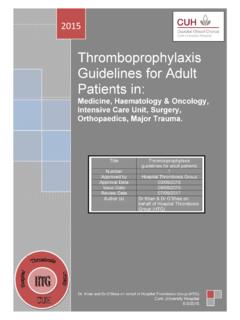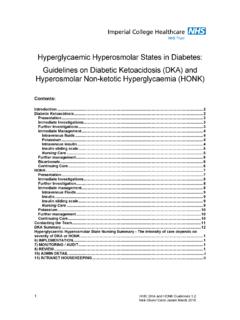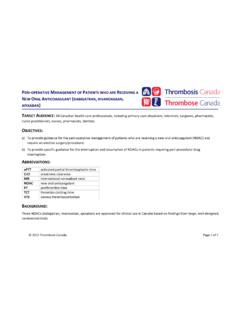Transcription of MANAGEMENT OF TRAUMA IN PREGNANCY …
1 Sign up to receive ATOTW weekly - email OF TRAUMA IN PREGNANCYANAESTHESIA TUTORIAL OF THE WEEK 1721ST MARCH 2010 Mario FernandesSpecialist Registrar in AnaesthesiaNinewells Hospital, Dundee, United to tutorial examines the common causes of TRAUMA in PREGNANCY , the mechanisms of injury and strategies to most effectively manage the mother and unborn Before continuing, try to answer the following questions. The answers can be found at the end of the article, together with a brief of the following statements regarding TRAUMA in PREGNANCY are correct?
2 Highest incidence of TRAUMA in PREGNANCY occurs in the 1st traffic accidents account for the majority of cases of TRAUMA Kleihauer-Betke test is not a useful test following TRAUMA onset of uterine contractions following TRAUMA may be the first sign of placental the MANAGEMENT of a term pregnant woman who has sustained serious traumatic lateral tilt should be considered after the primary survey is the event of cardiac arrest, delivery by peri-mortem caesarean section should be within 5 minutes of commencing cardiac compressions to be effective, left lateral tilt should be reduced to less than 15 abruption occurs in up to 50% of major injuries of the following statements are correct?
3 Mortality approaches 50% when the body surface area burn is >50 % increases the likelihood of pre-term reduce the risk of fetal TRAUMA , it is recommended that the lap strap of a 3 point seat belt be placed above the with heparin should be avoided following major TRAUMA in pregnancyATOTW 172 TRAUMA in pregnancy01/03/2010 Page 1 of 7 Sign up to receive ATOTW weekly - email 7% of pregnancies are complicated by TRAUMA with most traumatic events occurring during the 3rd trimester. Injuries sustained from road traffic accidents account for 70% of life threatening injuries.
4 Other causes of TRAUMA in PREGNANCY include accidents and falls at home and work, and injuries sustained as a result of domestic violence. Emergency teams who provide immediate care to the pregnant TRAUMA patient may be unfamiliar with the physiological changes of PREGNANCY and strategies to safely manage the fetus. Fetal loss is more common than maternal death and occurs in 40% of major & 2% of minor to the most recent UK Confidential Enquiry into Maternal and Child Health (CEMACH Saving Mothers Lives 2003-2005), 23 pregnant women or recently delivered mothers died as a result of road traffic accidents, including pedestrian accidents.
5 12 died undelivered and 8 died despite intense cardio-pulmonary resuscitation and peri-mortem caesarean section. None of the 8 babies delivered survived even though their gestational ages ranged between 24 and 38 weeks. INITIAL MANAGEMENTA pregnant TRAUMA victim in the late second or third trimester should be cared for in a centre that has an obstetric team on site for the MANAGEMENT of the ongoing PREGNANCY and/or delivery. A coordinated multi-professional approach is essential to ensure the best outcome for both mother and baby.
6 The team should include a senior obstetrician, anaesthetist, TRAUMA physician/surgeon, midwife and a paediatrician if delivery is of the pregnant TRAUMA patient follows the usual ABCDE TRAUMA approach (see below) but also includes some specific strategies: Left lateral tilt at the earliest opportunity The primary survey Assessment of fetal wellbeing & viability Secondary survey Definitive MANAGEMENT . Efforts should be made to obtain a history of the incident including mechanism of injury from the patient, bystanders and paramedic staff.
7 A complete past medical and obstetric history should be lateral tilt at the earliest opportunityFrom 20 week s gestation, the uterus may compress both the inferior vena cava and the aorta. The degree of compression is influenced by gestation, being greatest at term. It is also increased by multiple PREGNANCY , polyhydraminos and a large fetus. In the supine position, venous pressure in the lower limbs can be as high as 20-25 mm Hg, and the calibre of the aortic lumen reduced by 40%. The cardiac output of a pregnant woman in the supine position may be reduced by up to 25% compared with in the left lateral position.
8 A left lateral tilt of 15 degrees or more is essential to reduce aortocaval compression and maximise maternal cardiac output and fetal blood flow. Lateral tilt should be applied to the pregnant woman after 20 weeks gestation and can be achieved in a number of ways; however providing adequate tilt in some TRAUMA situations may be difficult. In cases where there is a possibility of spinal injury, patients should be immobilised on a spinal board and in these situations the whole spinal board can be tilted to the left. At the very least, the uterus should be manually displaced.
9 If the spine has been cleared, a wedge or pillow should be placed under the right hip. ATOTW 172 TRAUMA in pregnancy01/03/2010 Page 2 of 7 Sign up to receive ATOTW weekly - email Primary survey aims to identify and manage life threatening problems. The primary survey includes:Airway with cervical spine controlBreathing CirculationDisability or neurological statusExposure and environmental controlAll pregnant TRAUMA victims should receive high flow oxygen by face mask and early consideration given to securing the airway if there is concern.
10 The potential hazards of a full stomach and difficult intubation in pregnant women should be recognised and appropriate airway equipment made available. In the event of cardiac arrest, cardiopulmonary resuscitation (CPR) should be provided following Adult Life Support guidelines using the same resuscitation drugs and doses as for the non-pregnant patient. During CPR specific strategies to improve the chance of survival of both mother and baby should be employed (see later). Two large bore intravenous cannulae should be inserted in the upper limbs.












